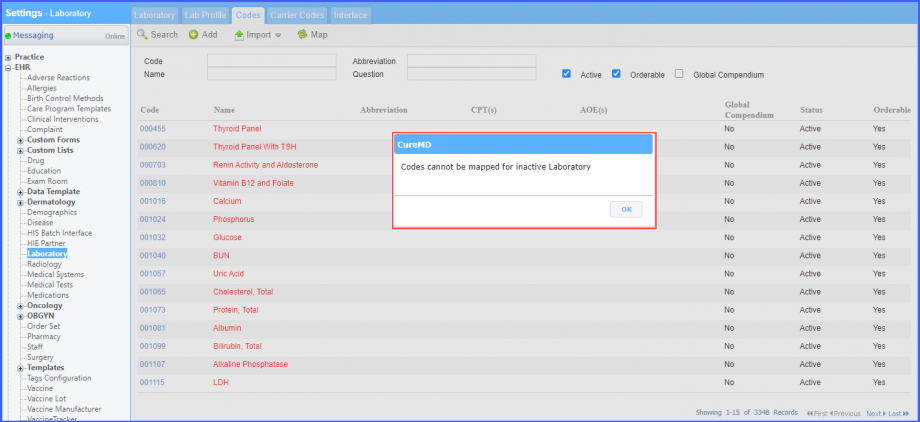How to Edit Codes for Laboratory?
Follow the above mentioned workflow to land on the ‘Codes’ page.
Click ‘Code’ hyperlink to edit a code.
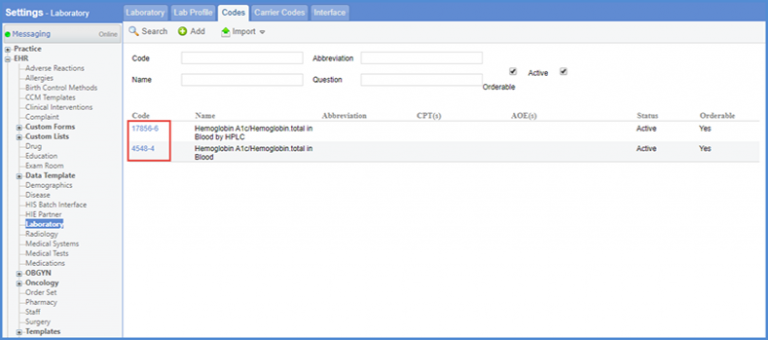
Selecting the required code will display the ‘Edit Code’ page.
A code can be marked ‘Active/Inactive’ and ‘Orderable’ from here.
Scroll down to the ‘Result Codes and LOINCS’ heading. Result observations can be added here.
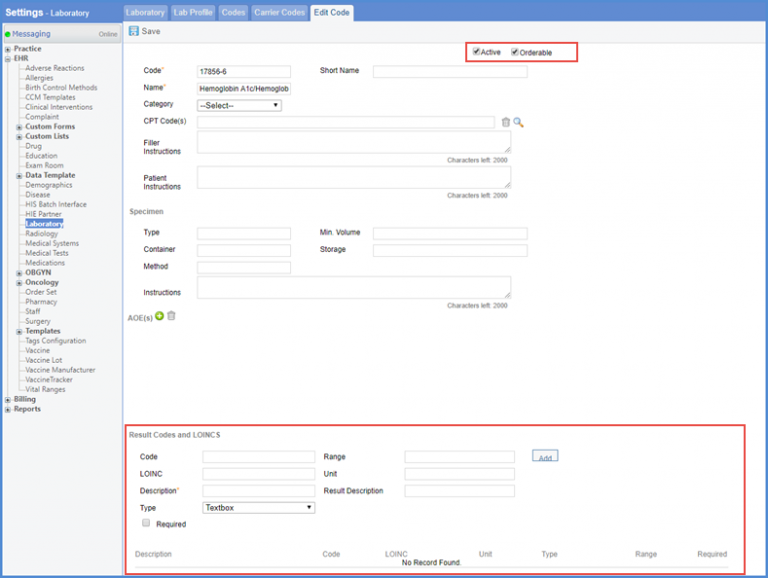
Under the ‘Result Codes and LOINCS’ heading the ‘Required’ checkbox allows users to choose which observation should be mandated when entering results.

Users are able to re-arrange the order of entered result observations.
Click, hold and drag the entire row to change the order.

A dropdown ‘Type’ field is added. This allows users to add test specific set of values for result description.
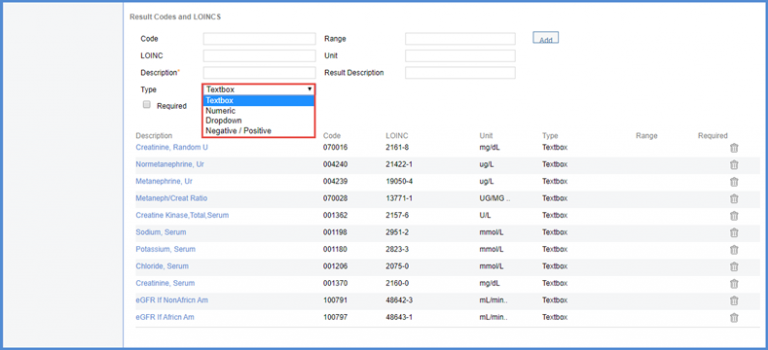
If users select ‘Numeric’ as ‘Type’, ‘Lower Limit’ and ‘Upper Limit’ fields are displayed.
Users can specify the range of the numeric result.
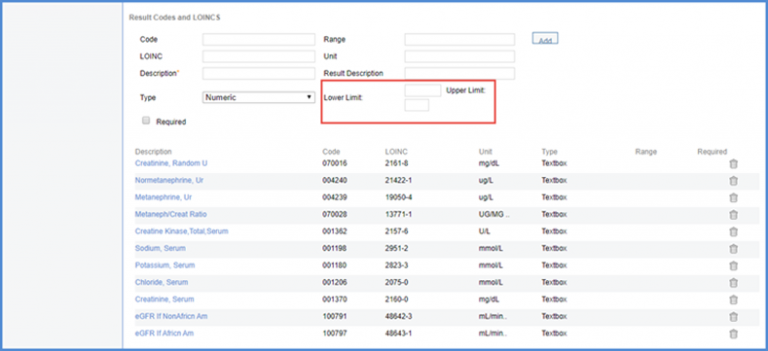
Selecting ‘Dropdown’ displays a ‘+’ icon. User can add dropdown values for results observation.
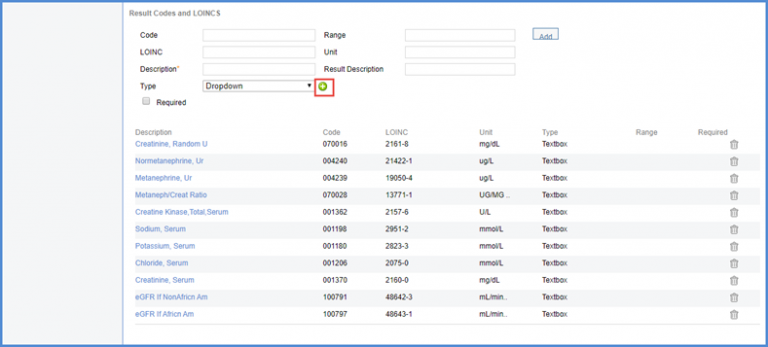
Dropdown values can be added as ‘text’ or ‘range’ and can be marked as default by checking the ‘default’ checkbox while adding dropdown values.
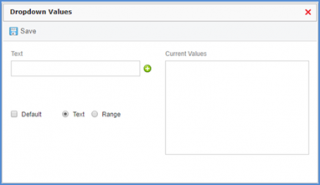
Similar attributes have been implemented for ‘Procedures’ heading ‘Result Codes and LOINCS’ settings.
Users can add codes to an electronic lab profile from the global compendium.
Select an electronic lab profile to edit. The lab profile should have a parser and a compendium selected for it. In order to see how to select a parser and a compendium, click here.
To add a code, click ‘+ Add’.

Type a code in the search bar to search the code in the global compendium. The search results are fetched from the compendium selected in the lab profile.

Select a code from the search results and the system populates the ‘Code’ and the ‘Name’ fields accordingly.
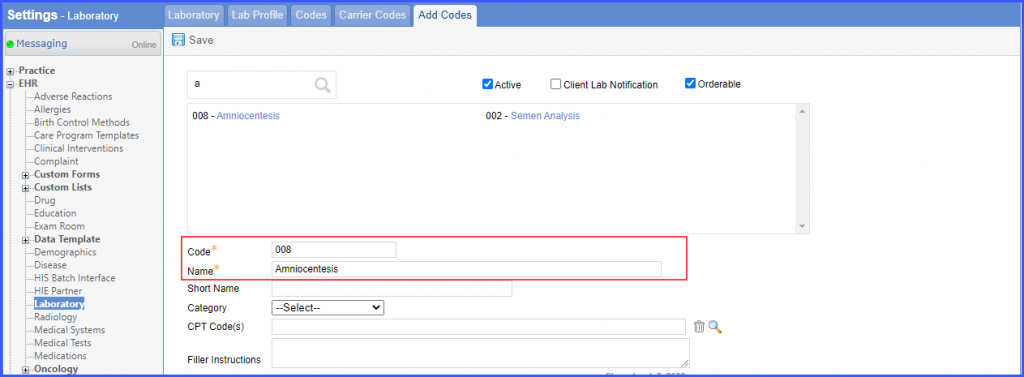
Alternatively, if no compendium has been selected in the radiology profile, then the users can enter the code and name manually in the ‘Code’ and ‘Name’ textboxes. Click ‘Save’ after adding the code.
Once the codes have been added to or imported into the lab profile, the system displays the unmapped codes in red.
Additionally, there is a ‘Global Compendium’ checkbox in the ‘Codes’ tab. Marking the checkbox displays the mapped codes and unmarking the checkbox displays the unmapped codes.
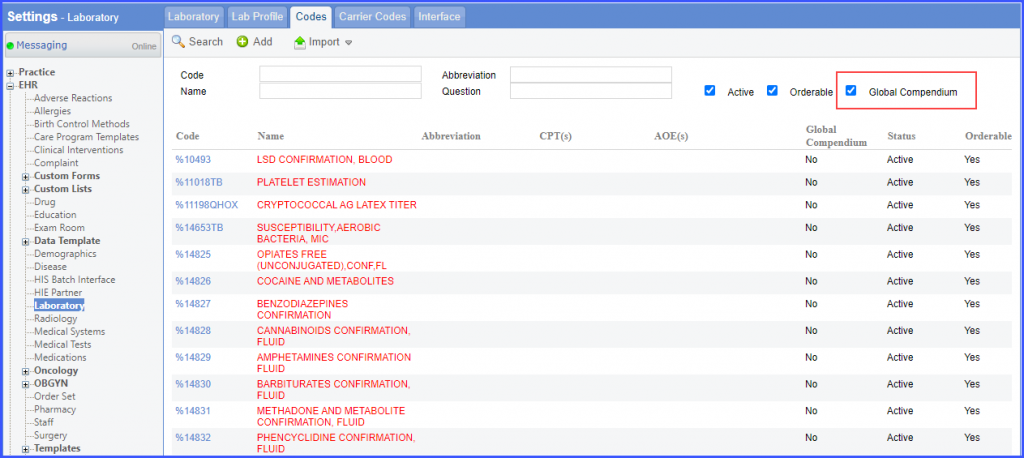
Lab codes can be mapped to the global compendium. This allows users to place orders for the mapped codes via treatment plan.
To map codes, click the ‘Map’ button. This action maps all common codes which are active and orderable to the global compendium.

Once the map button is clicked, the system displays a message which mentions the number of codes which are mapped and the number of codes which could not be mapped.

In case, a compendium has not been selected in the lab profile and the user clicks the map button, an alert message is displayed with the following message:
‘Please select a compendium to map codes.’

CPT or LOINC codes can be imported from the compendium to a lab profile.
Users do not have to manually associate CPT or LOINC codes with each test code.
Hover over ‘Import’ and select ‘Codes’.
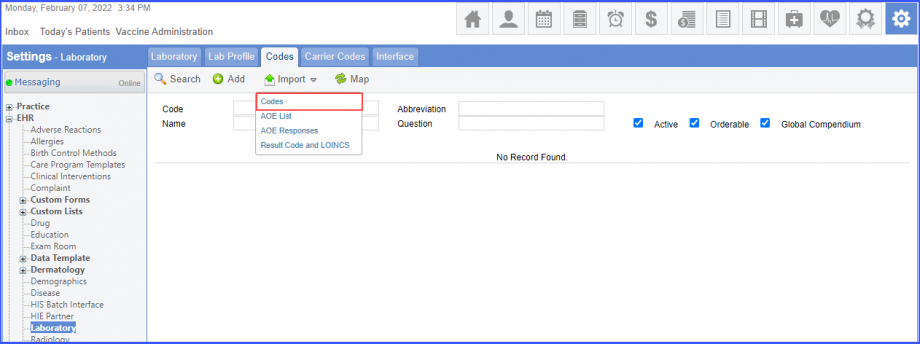
Choose a file and then click ‘Upload Excel File’.

After uploading a valid excel file, the mapping fields ‘CPT Codes’ and ‘Order LOINC’ are displayed.
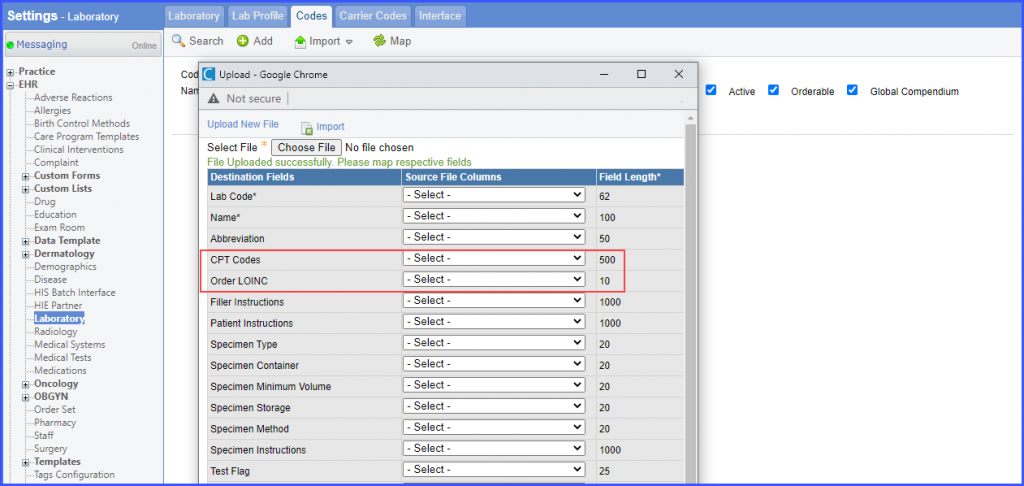
For mapping LOINC or CPT codes users can select an option from the dropdown of ‘Order LOINC’ or ‘CPT Codes’ respectively.
Then click the ‘Import’ button.
The system selects the characters in the mapped column and extracts it as the LOINC or CPT code for the test code. This process is repeated for each test code. When all the LOINC or CPT codes have been successfully uploaded a message is displayed to indicate the number of updated and the inserted records.

Lab codes can be unmapped from the global compendium.
This allows users to mark a lab code as inactive and edit its details before mapping it again.
Select a lab code which needs to be un-mapped from the compendium. Then, click the ‘UnMap’ button.

The system displays an alert message:
‘Code unmapped from global compendium successfully’.

Once the code is unmapped, the system enables ‘Active’ and ‘Orderable’ checkboxes, along with ‘Code’ and ‘Name’ fields. In addition, the ‘UnMap’ button changes to ‘Map’ button.

Users can edit the code details and map the code back to the compendium by clicking the ‘Map’ button.
LOINC codes can be added against lab test codes. This allows users to map LOINC codes with order codes.
Select a code to edit form the ‘Codes’ tab. In the ‘Edit Code’ tab the system displays a ‘LOINC Code’ text field. Users can enter a LOINC code here and then click ‘Save.

Users can identify duplicate codes in the lab compendiums. This allows users to update their lab compendiums with new codes and mark old codes as inactive.
Click ‘Add Code’ button to add a new code in the compendium. In case the user adds a lab code with a name that is already present in the compendium and clicks ‘Save’, the system displays a ‘Duplicate Codes’ pop-up.

If the user checks ‘Mark above duplicate codes as inactive’ and clicks ‘Save Code’, the system saves the new code in the compendium and the existing code is marked inactive.
Alternatively, if the user unchecks ‘Mark above duplicate codes as inactive’ and clicks ‘Save Code’, the system does not mark the existing code as inactive and the new code is saved in the compendium.
The system also checks for duplicate code names when a user selects an unmapped lab code and clicks the ‘Map’ button. A ‘Duplicate Codes’ prompt is displayed if codes with similar description already exist.

Furthermore, if a user uploads an excel file having codes with duplicate names, the ‘Duplicate Codes’ pop-up is displayed with a list of the duplicate names.
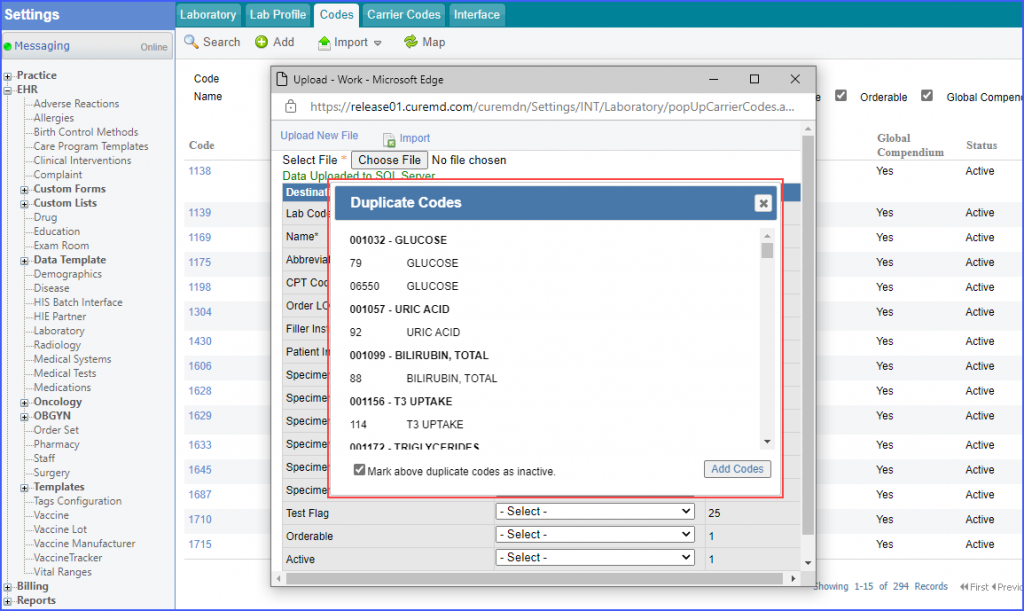
Click here, to view a similar enhancement made in the ‘Radiology’ section.
The user can associate forms with lab orders and results. 
This ensures necessary information can be sent to labs for appropriate patient care.
Navigate to the ‘Order Form’ and ‘Result Form’ section under ‘AOEs’ in the edit code page. The users can attach the forms by clicking on the ‘Form.io’ hyperlink.
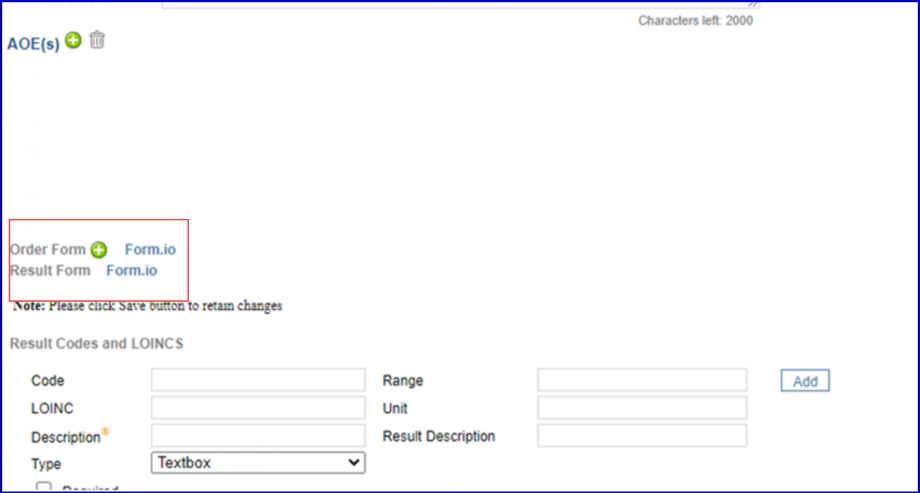
Clicking on the ‘Form.io’ hyperlink displays the ‘Forms’ window. Here, users can click on the required form to attach it with the lab code.

Only one form each can be attached with the lab order and result.
After the user adds the form, the ‘Add’ button is replaced by the ‘Delete’ icon. If the user deletes these forms, the system displays an ‘Add’ button again.
The user can also mark the forms as ‘Mandatory’.

After attaching the required forms, click ‘Save’.
Character limit of CPT Codes range field has been increased.
This ensures that users are compliant with CLIA requirements.
Navigate to ‘Result Codes and LIONCs’ section.
Click on the ‘Range’ field to add the reference range for a code. The system allows the user to type a maximum of 60 characters in the field.

Click here, to view a similar enhancement made in the ‘Radiology’ section.
Codes of inactive labs can be unmapped from global search. This ensures that users face no confusion while placing orders.
Navigate to ‘Codes’ tab of a laboratory that is marked inactive.
When the user clicks on ‘Map’ button, the system displays an alert stating:
‘Codes cannot be mapped for inactive labs’
